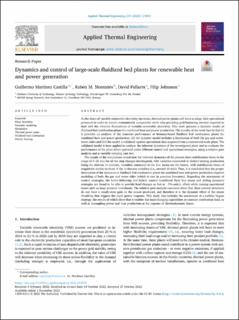| dc.contributor.author | Martinez-Castilla, Guillermo | |
| dc.contributor.author | Mocholí Montañés, Rubén | |
| dc.contributor.author | Pallarès, David | |
| dc.contributor.author | Johnsson, Filip | |
| dc.date.accessioned | 2023-05-08T12:09:33Z | |
| dc.date.available | 2023-05-08T12:09:33Z | |
| dc.date.created | 2022-11-06T18:29:52Z | |
| dc.date.issued | 2022 | |
| dc.identifier.citation | Applied Thermal Engineering. 2022, 219 B 119591-?. | en_US |
| dc.identifier.issn | 1359-4311 | |
| dc.identifier.uri | https://hdl.handle.net/11250/3067075 | |
| dc.description.abstract | As the share of variable renewable electricity increases, thermal power plants will have to adapt their operational protocols in order to remain economically competitive while also providing grid-balancing services required to deal with the inherent fluctuations of variable renewable electricity. This work presents a dynamic model of fluidized bed combustion plants for combined heat and power production. The novelty of the work lays in that (i) it provides an analysis of the transient performance of biomass-based fluidized bed combustion plants for combined heat and power production, (ii) the dynamic model includes a description of both the gas and water-steam sides and (iii) the model is validated against operational data acquired from a commercial-scale plant. The validated model is here applied to analyze the inherent dynamics of the investigated plant and to evaluate the performance of the plant when operated under different control and operational strategies, using a relative gain analysis and a variable ramping rate test. The results of the simulations reveal that the inherent dynamics of the process have stabilization times in the range of 5–25 min for all the step changes investigated, with variables connected to district heating production being the slowest. In contrast, variables connected to the live steam are the fastest, with stabilization times of magnitude similar to those of the in-furnace variables (i.e., around 10 min). Thus, it is concluded that the proper description of the dynamics in fluidized bed combustion plants for combined heat and power production requires modeling of both the gas and water sides (which is rare in previous literature). Regarding the assessment of control strategies, the boiler-following and hybrid control (combined fixed live steam and sliding pressure) strategies are found to be able to provide load changes as fast as −5%-unit/s, albeit while causing operational issues such as large pressure overshoots. The relative gain analysis outcomes show that these control structures do not have a steady-state gain on the power produced, and therefore it is the dynamic effect of the steam throttling that triggers the rapid power response. This study also includes the assessment of a turbine bypass strategy, the results of which show that it enables fast load-changing capabilities at constant combustion load, as well as decoupling power and heat production at the expense of thermodynamic losses. | en_US |
| dc.language.iso | eng | en_US |
| dc.publisher | Elsevier | en_US |
| dc.rights | Navngivelse 4.0 Internasjonal | * |
| dc.rights.uri | http://creativecommons.org/licenses/by/4.0/deed.no | * |
| dc.title | Dynamics and control of large-scale fluidized bed plants for renewable heat and power generation | en_US |
| dc.title.alternative | Dynamics and control of large-scale fluidized bed plants for renewable heat and power generation | en_US |
| dc.type | Peer reviewed | en_US |
| dc.type | Journal article | en_US |
| dc.description.version | publishedVersion | en_US |
| dc.rights.holder | The Authors | en_US |
| dc.source.volume | 219 B | en_US |
| dc.source.journal | Applied Thermal Engineering | en_US |
| dc.identifier.doi | 10.1016/j.applthermaleng.2022.119591 | |
| dc.identifier.cristin | 2069627 | |
| dc.source.articlenumber | 119591 | en_US |
| cristin.ispublished | true | |
| cristin.fulltext | original | |
| cristin.qualitycode | 1 | |

